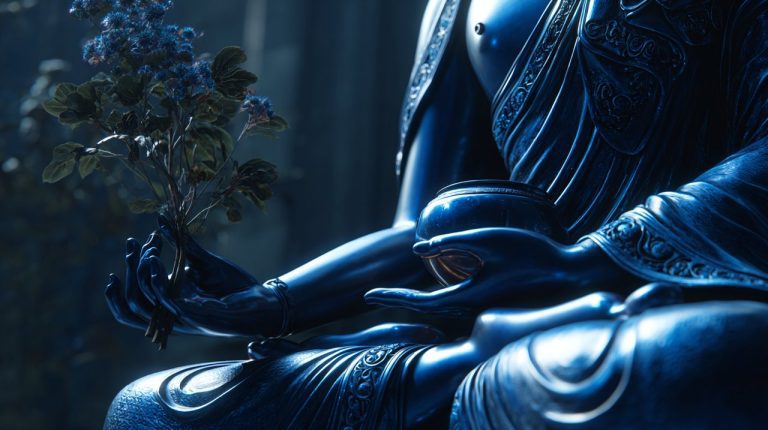Nirvana Day: Understanding Parinirvana and Buddhist Liberation
The concept of death often conjures feelings of fear or profound sorrow, marking what many perceive as an irreversible end. Yet, in Buddhism, the passing of Siddhartha Gautama—the historical Buddha—into Parinirvana is commemorated annually on 「Nirvana Day」 (also known as 「Parinirvana Day」) not with despair, but with deep reverence and a renewed sense of understanding.
This significant observance, one of the key 「Buddhist holy days」, challenges our conventional views of mortality. Instead of a mere physical cessation, it presents the ultimate demonstration of liberation.
Parinirvana: Understanding the Ultimate Liberation
「Parinirvana」, which literally means “complete nirvana,” signifies the final departure of an enlightened being from the cycle of rebirth (「samsara」) at the moment of physical death. This is distinct from the experience of nirvana achieved during one’s lifetime, which marks the cessation of suffering and attachment.
The Buddha’s Parinirvana represents the ultimate culmination of his teachings. It is the definitive cessation of 「samsara」 and suffering, serving as a powerful testament that complete 「spiritual liberation」 is truly attainable.
Unlike an ordinary death, which in 「Buddhist cosmology」 often implies a transition to another state within 「samsara」, Parinirvana marks the absolute end of all conditioned existence for the enlightened one. It’s not an entry into a heavenly realm, but a state transcending all realms, utterly free from craving, aversion, and ignorance. Think of it as finally stepping off a cosmic carousel that has spun for countless lifetimes, finding absolute stillness.
The Buddha’s Final Act: A Living Testament to His Teachings
The Buddha’s Parinirvana, meticulously recorded in the Mahaparinibbana Sutta, took place around 483 BCE in Kushinagar. His final moments were characterized by profound calm and clarity, during which he offered his last instructions to his devoted disciples.
This pivotal event encapsulates the very essence of his Dharma, particularly the fundamental truths of 「impermanence」 and the direct path to liberation.
The Profound Lesson of Impermanence
The Buddha’s last words, “All conditioned things are subject to decay. Strive with diligence,” serve as an incredibly powerful reminder of 「impermanence」. His own physical passing underscored a universal truth: even the most enlightened form is subject to change and eventual dissolution.
This teaching is absolutely fundamental to understanding the nature of existence and the inherent suffering that arises from our attachment to transient phenomena.
The Buddha’s Parinirvana is not an ending but a profound affirmation of the truth of 「impermanence」 and the possibility of transcending all conditioned existence.
The Path to Complete Cessation of Suffering
Parinirvana reinforces the core Buddhist teaching that suffering (dukkha) can cease entirely. For 45 years, the Buddha diligently taught the Four Noble Truths and the Eightfold Path, which together illuminate the way to end suffering.
His final departure from the physical world was the ultimate, irrefutable proof of his doctrine: that the cycle of rebirth and suffering can indeed be broken through the cultivation of wisdom, ethical conduct, and mental discipline.

Global Observances: How We Commemorate Nirvana Day
「Nirvana Day」 is observed by Buddhists across the globe, though the specific date and practices may vary subtly between different traditions. It is a day specifically designated for quiet contemplation, deep meditation, and thoughtful reflection on the Buddha’s extraordinary life and profound teachings.
Theravada Traditions: Reflection and Renewal
In countries where 「Theravada Buddhism」 is predominant, such as Thailand, Sri Lanka, and Myanmar, Nirvana Day (often integrated into observances like Magha Puja or Sangha Day) typically falls in February or March.
- Monasteries host special services, often featuring chanting and silent 「meditation techniques」.
- Practitioners make offerings, listen to Dharma talks, and reflect deeply on life’s impermanence.
- The focus is on renewing their commitment to the path of enlightenment.
Mahayana Perspectives: Compassion and Aspiration
Mahayana Buddhist traditions, commonly found in China, Japan, Korea, and Vietnam, also commemorate Nirvana Day. While the primary focus remains on the Buddha’s passing, some Mahayana schools emphasize a truly profound aspect:
The Buddha’s compassionate choice to remain in 「samsara」 as a Bodhisattva through countless previous lives, delaying his own ultimate liberation until all beings could be freed. This perspective adds a powerful layer of altruistic aspiration to the observance, inviting us to reflect not just on individual liberation, but on our interconnected journey towards universal peace.
Ceremonies often include readings from the Mahaparinirvana Sutra, which further expands on the Buddha’s final, transformative teachings.
Integrating Parinirvana’s Wisdom into Our Lives
「Nirvana Day」 serves as an annual invitation to integrate the profound wisdom of Parinirvana into our everyday existence. It gently encourages us to confront our own attachments and fears of change, guiding us to recognize that true liberation stems from understanding and accepting 「impermanence」.
Reflecting on the Buddha’s ultimate example can inspire us to cultivate mindfulness, compassion, and wisdom in our own lives. By engaging in 「meditation techniques」 and studying the Dharma, we effectively walk the path the Buddha illuminated, moving steadily towards our own 「spiritual liberation」.
This day is a powerful reminder that while life is inherently transient, the potential for ultimate peace is ever-present and always within our reach. Far from being a somber occasion, 「Nirvana Day」 is a vibrant affirmation of the Buddhist path. It underscores that the cessation of suffering is not merely a theoretical concept, but a living truth powerfully demonstrated by the Buddha himself. Through reflecting on Parinirvana, we are invited to deepen our understanding of our own existence and embark on the profound journey towards ultimate freedom. This annual observance thus provides a powerful impetus for continued practice and a deeper engagement with the timeless teachings of Buddhism.
💡 Frequently Asked Questions
Parinirvana, meaning "complete nirvana," signifies the final departure of an enlightened being from the cycle of rebirth (samsara) at the moment of physical death. This is distinct from nirvana achieved during life, which is the cessation of suffering and attachment. Parinirvana represents the ultimate culmination of teachings, the definitive end of samsara and suffering, proving spiritual liberation is attainable.
Nirvana Day, also known as Parinirvana Day, commemorates the passing of Siddhartha Gautama, the historical Buddha, into Parinirvana. It is observed not with sorrow, but with reverence and a renewed understanding of Buddhist teachings. It challenges conventional views of mortality by presenting the Buddha's passing as the ultimate demonstration of liberation and the cessation of suffering.
The Buddha's last words, "All conditioned things are subject to decay. Strive with diligence," along with his physical passing, powerfully underscore the universal truth of impermanence. His own enlightened form was subject to change and dissolution, highlighting that attachment to transient phenomena leads to suffering. Parinirvana affirms impermanence and the possibility of transcending conditioned existence.
In Theravada traditions (e.g., Thailand, Sri Lanka), Nirvana Day often involves special services, chanting, and meditation, focusing on renewing commitment to the path of enlightenment and reflecting on impermanence. Mahayana traditions (e.g., China, Japan) may emphasize the Buddha's compassionate choice to remain in samsara as a Bodhisattva, adding a layer of altruistic aspiration and often including readings from the Mahaparinirvana Sutra.
Nirvana Day invites us to integrate Parinirvana's wisdom by confronting our own attachments and fears of change, recognizing that true liberation comes from understanding and accepting impermanence. Engaging in meditation techniques and studying the Dharma, as illuminated by the Buddha, helps us walk the path towards spiritual liberation and find ultimate peace.







